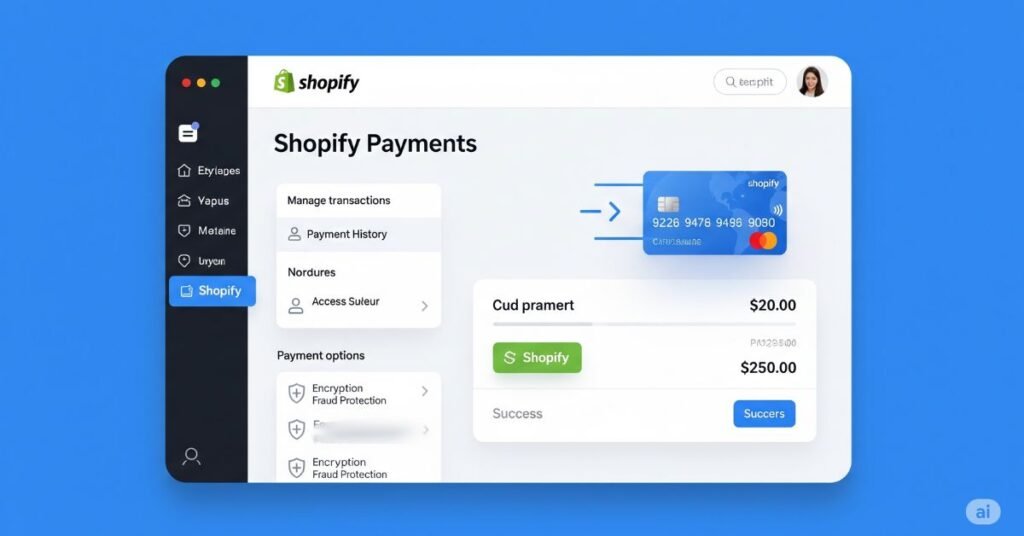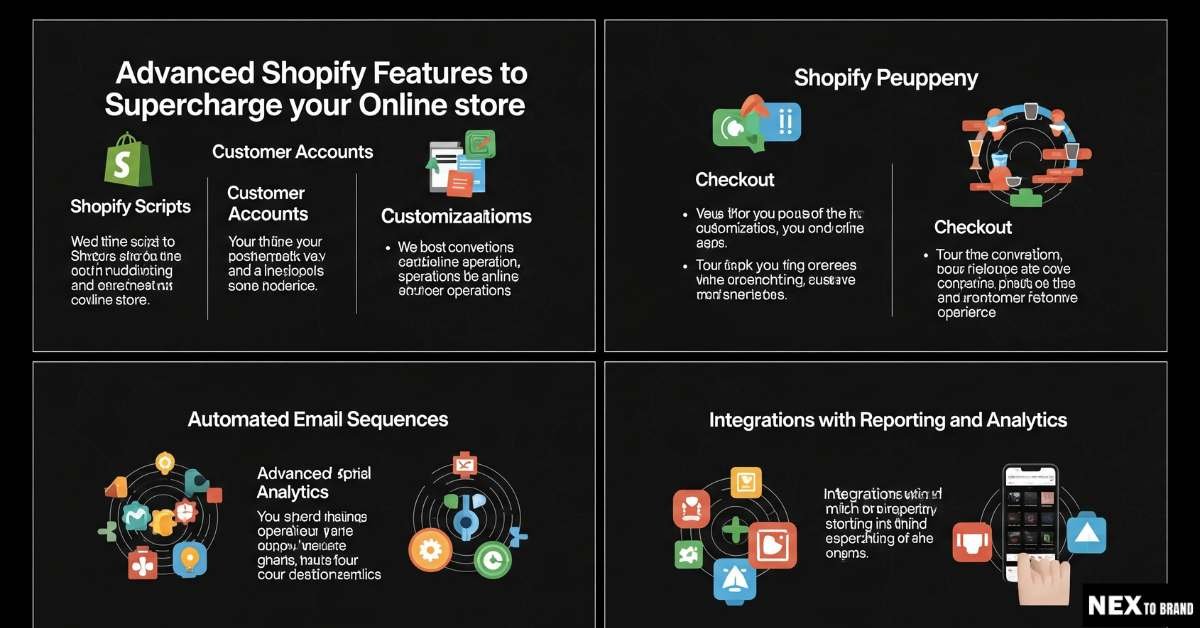When I launched my first Shopify store, I didn’t realize just how much the Shopify payments setup could impact sales—until I lost a few at checkout. Setting up your payment gateway isn’t just a tech task; it’s the moment your customer decides to trust you with their money. From credit card processing to PayPal and Stripe, I’ve tested it all to find what actually works. In this guide, I’ll walk you through how to get paid faster, reduce friction, and build a seamless checkout process that converts. Let’s dive in and set your Shopify store up for real success.
Table of Contents
Getting Started with Shopify Payments Setup
What is Shopify Payments?
Shopify Payments is the tool that lets you accept payments directly in your store. You don’t need a third-party service. It works with credit cards, Apple Pay, and other methods. Everything runs inside your Shopify dashboard.
When I first started my store, I used PayPal and Stripe separately. It worked, but it was messy. Switching to Shopify Payments made life easier—and faster. I could track orders, payments, and refunds all in one place.
Why It Matters (Conversion Rate, Trust, and Fees)
A smooth Shopify payments setup builds trust and helps you earn more. If your checkout feels slow or confusing, people leave. I learned this the hard way. My first few sales dropped off at the last step—because I didn’t offer the right options.
Shopify Payments speeds up the process. It also lowers fees since you’re not paying extra to outside processors. And faster payments to your bank? That’s a win.
Step-by-Step: How to Activate Shopify Payments
Setting up Shopify Payments takes just a few steps. Here’s how you can do it fast:
- Go to Settings in your Shopify dashboard
- Click Payments
- Choose Shopify Payments
- Click Complete Account Setup
- Enter your business info, bank account, and tax details
- Upload a photo ID (like a license or passport)
- Click Submit
You’ll be ready to accept payments in minutes. I remember feeling relieved—no extra apps or tech needed.
Supported Countries and Credit Card Types
Shopify Payments is currently available in over 20 countries, including the U.S., Canada, UK, Australia, and much of Europe. It supports major credit and debit cards, plus local methods like iDEAL, Bancontact, and Sofort where applicable.
Here’s a quick tip: Before you start, check Shopify’s official list of supported countries to make sure yours is included. I once helped a friend from India try to enable it, only to realize it wasn’t supported there—so we had to use Razorpay instead.
Accepted card types include Visa, Mastercard, American Express, Discover, and more. Depending on your region, you can also enable Shop Pay, Apple Pay, and Google Pay to give your customers even more flexibility.
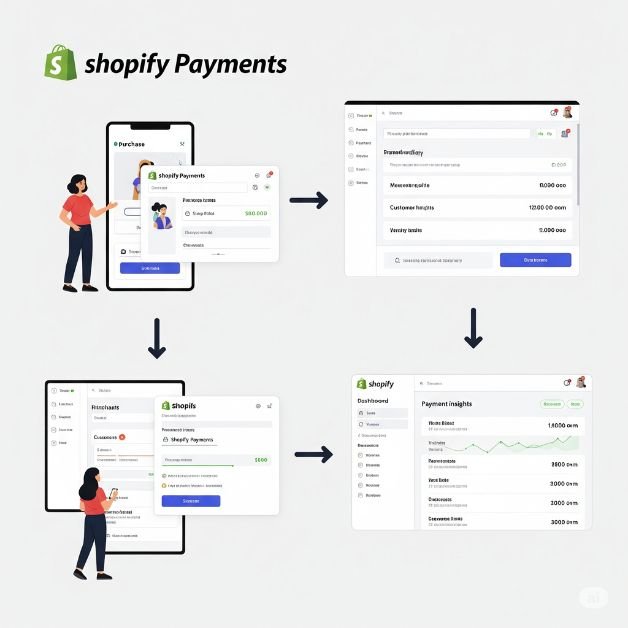
Shopify Payment Gateway Setup Explained
Built-in vs. Third-Party Gateways
Shopify gives you two ways to collect payments. One is its built-in system called Shopify Payments. The other is third-party gateways like PayPal, Stripe, or Authorize.net. The built-in option is easier to set up. It also cuts out extra fees because you don’t need another service.
When I first opened my store, I used both Stripe and PayPal. It worked, but it got messy. I had to log into different places to track payments. Later, I switched to Shopify Payments. It was faster, simpler, and cheaper. If your country supports it, Shopify Payments is usually the best place to start.
Using Shopify’s built-in gateway is often the simplest and most cost-effective option for new store owners.
How to Connect PayPal, Stripe, and Other Gateways
If you want to add a third-party gateway like PayPal or Stripe, the steps are easy. Go to your Shopify dashboard, click Settings, then Payments. Scroll to Third-party providers, and choose the one you want. Then connect your account and follow the steps.
When I linked PayPal, it pulled the email I used to open my store. I had to verify my PayPal account before it worked. Stripe was even easier. I just logged in, and it was ready to go. No tech skills needed. You can connect PayPal or Stripe in a few clicks, right inside your Shopify settings.
Shopify Payments vs PayPal vs Stripe
Here’s a quick comparison based on my own experience:
| Feature | Shopify Payments | PayPal | Stripe |
| Setup Time | Very quick | Quick | Quick |
| Extra Fees | No | Yes | No |
| Checkout Flow | Stays on site | Redirects to PayPal | Stays on site |
| Best Use Case | General stores | Buyers with PayPal | Subscriptions or custom |
| Payout Time | 1–3 days | 3–5 days | 2–7 days |
Shopify Payments is great if you want things simple. It works well for most stores. PayPal is good if your buyers already trust it. Stripe is best if you sell digital goods or need recurring payments. I’ve used all three, and for my physical product store, Shopify Payments worked best.
Shopify Payments is often the easiest and most reliable way to accept payments for general online stores.
Which Payment Gateway Should You Use?
Different stores need different tools. If you are just starting out, go with Shopify Payments. It works out of the box and supports major cards and wallets. If you sell subscriptions or digital products, Stripe is a solid choice. And if your buyers prefer PayPal, offer that too.
I once helped a client with a digital learning platform. They needed automatic billing every month. Stripe handled it without a problem. On my current store, I use Shopify Payments and PayPal together. That way, customers can pick what they trust.
For most stores, using Shopify Payments with PayPal covers all your bases while keeping things simple.
Shopify Credit Card Processing Demystified
How Shopify Handles Credit Card Payments
Shopify makes it easy to take card payments. Once you turn on Shopify Payments, your store is ready. You can accept Visa, Mastercard, Amex, and more—right away.
Quick answer: Shopify handles credit card payments inside your store, with no extra tools needed.
When I got my first sale, I was shocked. The payment just worked. No PayPal logins. No Stripe delays. It showed up in my Shopify dashboard, ready to go. It felt like magic.
You don’t need to set up anything else. All the tracking, refunds, and payout info is in one place.
Fees, Chargebacks, and Processing Times
Shopify takes a small cut from each sale. Most stores in the U.S. pay 2.9% + 30¢ per card charge. It’s clear, with no surprise fees.
Quick answer: Shopify charges a fee per sale, and sends money to your bank in 1–3 days.
You’ll also deal with chargebacks. That’s when a customer tells their bank to cancel the payment. Shopify gives you tools to fight back. I lost my first chargeback because I didn’t know what to send. Now, I always save tracking info and screenshots.
Most payouts show up in your bank in 1–3 business days. Fast cash flow keeps your store running smooth.
Tips to Reduce Transaction Fees
Want to keep more money? Use Shopify Payments instead of third-party services. If you use PayPal or Stripe alone, Shopify adds extra fees. That stacks up fast.
Quick answer: Use Shopify Payments to avoid extra fees and keep more profit.
Here’s what I learned:
- Stick with one gateway. It keeps things simple.
- Offer local payment types. In other countries, these can cost less.
- Look at your plan. Bigger plans have lower fees. It might be worth the upgrade.
Chargebacks can hurt. I use an app now that replies for me. It sends proof when someone disputes a charge. It saved me more than once.
Final Thought
Credit card payments on Shopify are easy. You just need to set them up right. I made a few mistakes at first—but you don’t have to. Keep it simple. Use the right tools. And protect your profits from fees and fraud.
Shopify Multi-Currency Setup for Global Selling
Why Multi-Currency Matters for International Sales
If you sell to people in other countries, pricing matters. Buyers feel better when they see prices in their own money. It builds trust and helps you get more sales.
Quick answer: Shopify multi-currency shows local prices, which helps buyers feel safe and boosts sales.
I lost a sale once because I showed U.S. dollars to a buyer in Germany. They messaged me confused. After I turned on multi-currency, those questions stopped—and my sales went up.
People like shopping in their own currency. It feels normal. And normal leads to more checkouts.
Enabling Multi-Currency on Shopify Payments
You need Shopify Payments to use multi-currency. That’s a must. Without it, you can’t offer prices in different currencies.
Quick answer: Use Shopify Payments to show prices in many currencies and reach more buyers worldwide.
Here’s how to turn it on:
- Go to Settings → Payments
- Click Manage next to Shopify Payments
- Scroll to Countries/Regions
- Pick the currencies you want to add
That’s it. Shopify updates the prices for you using daily rates. You can even round prices to make them look clean. I did this and saw fewer abandoned carts.
You can also set price rules by region. That helped me fix price gaps caused by higher shipping fees.
How Currency Conversion Affects Pricing, Shipping, and Tax
Currency changes can affect your store. Prices may go up or down based on exchange rates. You can add a small fee to cover that shift.
Quick answer: Currency conversion changes prices slightly, so check your settings often.
Shipping is a big part too. If you add a new country, make sure you can ship there. I forgot this once. I had the currency set for Japan but didn’t offer shipping. That sale was gone.
Tax rules also change by country. Shopify helps with this. If you sell in the U.S., it adds tax by state. In the EU, it helps you follow VAT laws.
Before you turn on a new currency, ask: Can I ship there? Can I handle taxes? If yes—go for it.
Final Thought
Shopify’s multi-currency feature is a simple way to grow. You don’t need to change your store. Just show prices that feel local to your buyers.
Quick takeaway: Multi-currency makes global selling easier and helps shoppers feel at home in your store.
After I set it up, I got orders from places I never expected. One was from Norway—no ad, no promo. Just a clean price in the right currency.
That’s the power of local pricing.
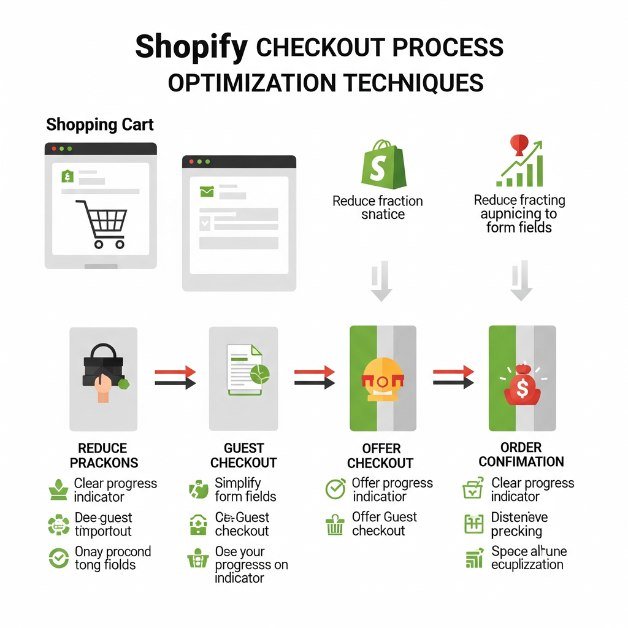
Shopify Checkout Process Optimization
Best Practices for Optimizing the Shopify Checkout Page
A great checkout page is like a clean kitchen—everything in its place, no clutter, and easy to use. The smoother it is, the more sales you’ll see. A fast, simple checkout keeps buyers from changing their minds.
Most people drop off at checkout when it’s too long or confusing. That’s why fewer fields, fewer clicks, and clear buttons work best. Let users check out as guests. Show total costs early. Keep it quick, clean, and clear.
When I started, I had too many steps and asked for too much info. Fixing that made a huge difference. Sales went up almost right away.
One-Page Checkout vs. Multi-Step: What Works Better?
When it comes to layout, one page often beats many. A one-page checkout is easier to use and feels faster. That speed helps people finish the purchase instead of dropping off.
I used multi-step checkout at first, thinking it looked more “pro.” But it slowed things down. Switching to one page cut the bounce rate and boosted sales. It felt like flipping a switch.
Multi-step still works for some stores, like subscriptions or custom builds. But for most shops, one page wins. It’s less work for the buyer—and less work means more sales.
Trust Signals, Mobile Optimization, and Upsells at Checkout
People get nervous when it’s time to pay. That’s why showing trust is key. Things like lock icons, “Secure Checkout” text, and payment logos build comfort. When buyers feel safe, they’re more likely to click “Buy.”
Adding trust badges helped me cut abandoned carts by 15%. I also show reviews on the checkout page, which adds even more confidence.
Mobile is huge. Over 70% of my shoppers use phones. If your checkout doesn’t load fast or look clean on mobile, you’ll lose people. Make sure buttons are big, text is easy to read, and pages load quick.
And don’t skip upsells. I add a low-cost item at checkout—like $4.99 for a small add-on. It brings in extra money with almost no extra work.
My Experience with A/B Testing Shopify Checkouts
Small tests can lead to big wins. I used to guess what would work, but now I run simple A/B tests to find the best layout, button text, and colors. Testing helps you see what your buyers really want.
One change that worked? I switched my button from “Continue” to “Pay Now.” That small tweak boosted conversions by 6%. Another time, I moved trust badges under the pay button—and that improved trust without slowing things down.
I test one change at a time. That way, I know what made the difference. Tools like Google Optimize and Shopify apps make it easy, even if you’re not techy.
Final Thought
Your checkout page is the last stop before a sale. If it’s slow, clunky, or confusing, people leave. But if it’s fast and friendly, they buy—and come back.
After fixing mine, I saw more orders, fewer support questions, and higher cart values. It’s one of the best things I ever did for my store.
If you want more sales, start here. Make checkout smooth, simple, and safe. Your future self will thank you.
Shopify Tax Settings: What You Need to Know
Setting Up Tax Rates by Region
Taxes can feel like a headache—but once you get it right, it’s smooth sailing. Shopify lets you set up tax rates by region, so you’re covered whether you sell in one state or worldwide.
Quick answer: Shopify lets you automate tax rates by country, state, or province so you stay compliant without doing the math.
When I first launched, I assumed Shopify would “just handle it.” But I found out each U.S. state has different rules. Some charge tax on shipping. Others don’t. I had to dig in, set rates by state, and double-check them. Luckily, Shopify makes this easier with automatic tax settings.
If you’re in the U.S., Shopify detects the customer’s address and applies the right rate. For other countries, you can add regions manually or use Shopify’s built-in defaults. It only takes a few clicks.
How Shopify Handles U.S. Sales Tax Compliance
If you sell in the U.S., this part matters. Each state has its own rules, and some even require tax on clothing, digital goods, or shipping.
Quick answer: Shopify automatically calculates U.S. sales tax based on customer location and product type.
I live in a sales-tax state, and when I made my first out-of-state sale, I panicked. Was I supposed to charge tax? File something? Turns out, Shopify helps with this. If you set your business location, it figures out where you have to collect tax.
Shopify also supports economic nexus rules. That means if you sell enough in a state—even without a physical presence—you may owe tax there. This used to be overwhelming, but now I get reminders and reports that make filing easier.
For peace of mind, I always check my tax liability every quarter. Shopify’s sales reports help you stay ahead.
Tools and Apps to Help with Tax Automation
If you’re managing sales in more than a few regions, apps can save your sanity. There are several tools built for Shopify that handle complex tax setups, especially if you sell digital goods or across borders.
Quick answer: Apps like Avalara and TaxJar automate Shopify tax collection, filing, and compliance.
I used to keep track in a spreadsheet (don’t recommend). When sales grew, I added TaxJar, and it was a game-changer. It pulled data from Shopify, matched it to state rules, and even told me when I passed nexus thresholds.
Some tools also let you file taxes straight from the dashboard. That means no guesswork and no missed deadlines. Avalara is another solid option for bigger brands or multi-channel sellers.
The best part? These tools grow with your store. Start simple, then scale when needed.
A Quick Note on VAT for International Stores
If you sell in the EU, UK, or other regions with Value Added Tax (VAT), you’ll need a different setup.
Quick answer: Shopify supports VAT collection and includes settings for EU tax laws and digital goods.
I worked with a friend who launched her store in Germany. We had to register for a VAT ID, then set tax-included pricing for EU countries. Shopify handled it, but we had to enable the correct settings first.
You can choose whether to show VAT-included pricing or add it at checkout. In Europe, shoppers expect to see tax in the price upfront. Shopify gives you control over this.
For digital goods or B2B sales, you can also collect and validate VAT numbers—Shopify has native tools and apps that help you stay compliant.
If you’re not sure, start by checking your local laws, then update your tax settings accordingly.
Final Thought
Taxes might not be fun—but they’re crucial to running a trusted, legal online store.
Main takeaway: Set up Shopify tax settings once, and let the platform automate the hard parts.
When I took taxes seriously, I stopped worrying. No more last-minute scrambling or wondering if I was compliant. Shopify did most of the work—I just needed to set it up right the first time.
If you’re just starting out, keep it simple. Use Shopify’s built-in settings, and upgrade to a tax app when sales pick up. You’ll save time, avoid fines, and sleep better at night.
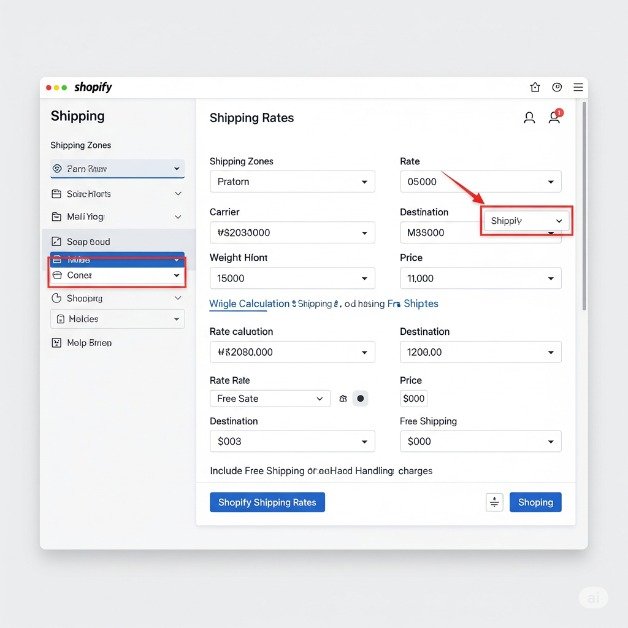
Shopify Shipping Rates Setup
Flat rate vs. weight-based vs. carrier-calculated
How shipping affects checkout and payment conversions
Personal insight: Mistakes I made and how I fixed them
Shipping might seem like a backend task, but it’s actually front and center when it comes to making or losing a sale. If a customer hits your checkout page and sees a weird shipping cost—or worse, no options at all—they’re gone. I didn’t get that until I lost three orders in one week, all because my shipping setup looked like I made it up on the spot. That was the wake-up call I needed.
Flat Rate vs. Weight-Based vs. Carrier-Calculated
There are three main ways to set up shipping on Shopify: flat rate, weight-based, and carrier-calculated. Flat rate shipping charges the same fee no matter what someone orders, which keeps things simple and predictable. It’s great if you sell mostly similar-sized items or want to offer “free shipping over $50” deals.
Weight-based shipping adjusts the cost depending on how much the order weighs. This is better if you sell items with a big size range—like shirts and kettlebells—because it helps protect your margins. You’ll just need to enter accurate weights for each product, or things can get messy fast.
Carrier-calculated shipping pulls live rates directly from couriers like USPS, UPS, or DHL. It’s the most accurate option, especially for international or high-volume orders, because customers see real-time shipping costs based on their address. The only downside? If you don’t control those rates, unexpected prices can scare people off.
I started with flat rates because I didn’t want to overthink it. As my catalog grew, I added weight-based tiers, and eventually plugged in real-time rates for bulk and overseas orders. That combo worked like a charm—simple for locals, smart for global.
How Shipping Affects Checkout and Payment Conversions
High or confusing shipping costs are one of the top reasons customers abandon their carts. Even if someone loves your product, a surprise $12 shipping charge at checkout can stop them cold. When your shipping setup is clear, fair, and fast, more people will complete their purchase.
The first time I tested free shipping over $60, my average order value shot up. Customers wanted to reach that minimum. But the real shift happened when I made my shipping info obvious right on the product page. No more guesswork. Just clean, upfront expectations.
Your shipping strategy is part of your pricing psychology. It influences how people feel during those final seconds before clicking “Buy.” If they feel unsure or blindsided, they’ll bounce. But when it feels like a deal, they’re more likely to check out happily.
Personal Insight: Mistakes I Made and How I Fixed Them
I used to think shipping was just plug-and-play. Set some prices, pick a zone, done. But I made a ton of mistakes—like not setting maximum weight limits or forgetting to include Canada in my zones. One time, someone from Toronto messaged me like, “Hey, your store says you don’t ship here.” That order could’ve been mine if I had set things up right.
Another mistake was overcharging without realizing it. I had products with no weight listed, so Shopify defaulted them to the highest tier. Customers were seeing $18 shipping for a single t-shirt. No one was buying, and I couldn’t figure out why until I did a test checkout myself.
Eventually, I cleaned it all up. I simplified zones, used standard box sizes, double-checked every product’s weight, and previewed checkout rates from different countries. I also set free shipping for my best-selling items and saw conversion rates improve almost overnight.
Now, I review my shipping settings every quarter, just to make sure nothing slipped through the cracks. A few small tweaks can lead to more sales, fewer abandoned carts, and happier customers.
Final Thought
Shipping isn’t just logistics—it’s part of your customer’s first impression. The smoother and more transparent it is, the more likely they are to trust you and buy. Whether you go with flat rates for simplicity, weight-based for flexibility, or carrier-calculated for accuracy, the key is making it easy to understand and fair.
After cleaning up my shipping strategy, I saw fewer support emails, more repeat buyers, and an increase in overall revenue. It’s not just about how fast you ship—it’s about how easy you make it to say yes.
Fraud Protection and Secure Payments on Shopify
Built-in fraud analysis features
Using 3D Secure, CVV verification, and risk analysis
Recommended apps and tools for fraud prevention
The first time I got hit with a chargeback, it stung. Not just the money—I lost a $75 order—but the feeling that someone had walked out of my store without paying. That’s when I realized: protecting your store isn’t just about shipping fast or building trust. It’s about setting up smart guardrails so you don’t lose money to fraud. Shopify gives you solid tools to start with, and a few tweaks can save you from some painful surprises.
Shopify’s Built-In Fraud Analysis: Your First Line of Defense
Shopify includes a built-in fraud analysis tool that flags risky orders before they become a problem. It checks for red flags like mismatched billing info, high-risk IP addresses, and suspicious order patterns. You’ll see these alerts right on the order page, with labels like medium risk or high risk.
Quick answer: Shopify automatically scans each order for fraud signals and warns you if something looks off.
I remember getting an order with overnight shipping to a totally different billing address. Shopify flagged it as high-risk, and thank God I didn’t ship it. A week later, the charge was reversed. That feature alone saved me from a $200 loss.
Always review high-risk orders before you fulfill them. A simple phone call or email can confirm if it’s real. If you’re unsure—refund it. It’s not worth the gamble.
How 3D Secure, CVV Checks, and Risk Filters Keep You Safe
If you use Shopify Payments, you automatically get support for 3D Secure. It’s a card authentication step that shifts liability away from you and onto the card issuer. That’s a huge deal—especially for high-ticket items.
Quick answer: 3D Secure adds an extra verification step that reduces fraud and chargeback risk.
CVV checks (those 3 digits on the back of a card) are also enabled by default. If the code doesn’t match, Shopify can reject the order. Simple, but powerful.
I once had a customer fail the CVV check twice. The third time it worked—but I still got a fraud warning. Turned out they were using a friend’s card. I canceled the order and avoided a potential mess.
You can also use manual risk review for big orders. I personally check anything over $300, just to be safe. A few minutes of caution now beats hours of headache later.
Top Apps and Tools for Extra Fraud Protection
Shopify’s native features are great, but if you’re scaling or dealing with a lot of orders, you might want extra protection. There are apps that go even deeper—some even auto-cancel high-risk orders before you see them.
Quick answer: Apps like FraudBlock, Signifyd, and NoFraud add advanced fraud detection and auto-rejection tools to Shopify.
I used FraudBlock during the holidays when order volume exploded. It caught three fake orders before I even opened my laptop. No stress, no disputes.
Signifyd is great if you want insurance on orders. They’ll actually cover the cost if a chargeback happens—so you’re not left eating the loss. It’s not cheap, but for high-risk niches like electronics or fashion, it might be worth it.
Another option is NoFraud, which runs real-time background checks on every customer. I know a store owner who swears by it—especially for international orders where fraud is harder to spot.
Final Thought
Protecting your Shopify store from fraud isn’t about paranoia—it’s about being smart. You worked hard to earn every sale. Don’t let scammers take that away from you.
Main takeaway: Shopify’s built-in fraud tools plus 3D Secure and CVV checks give you strong protection, and adding apps like FraudBlock or Signifyd can take it even further.
I’ve learned that it’s better to cancel one sketchy order than deal with weeks of emails, paperwork, and stress. The goal is peace of mind—for you and your customers. Set up your protection now, and sleep better knowing your store is safe.
Abandoned Cart Recovery and Payment Completion
How Abandoned Carts Affect Payment Success Rate
Abandoned carts are a big deal. You know when someone fills their cart, heads to checkout, but never hits “Buy”? It happens a lot. In fact, around 70% of carts are abandoned. That means a lot of sales slip away.
If you don’t act, that’s a lot of missed money. The good news? You can win those customers back with the right tools.
Using Shopify’s Built-in Recovery Tools
Shopify helps by sending automatic emails to remind people about their abandoned carts. It’s simple. You can set it up once, and Shopify does the rest. The emails can be customized. You can even offer a discount or free shipping.
Quick answer: Shopify sends email reminders automatically to help recover abandoned carts.
When I started using this feature, I noticed more people returned to finish their purchase. It made my life easier because I didn’t have to chase them down.
Email Automation, SMS Reminders, and Discounts
You can do even more with email and SMS. People check their phones often. A quick text reminder can bring them back.
Quick answer: Add SMS messages and discounts to boost your chances of recovering a cart.
I used SMS for the first time, and the response was great. I also offered a small discount, like 10%. It worked wonders. But be careful—don’t make it too big, or they might only shop when there’s a sale.
My Success Story: Increasing Recovery by 27% in 30 Days
When I started using these tools right, the results were huge. In just 30 days, I recovered 27% more abandoned carts. Here’s how I did it:
- Set up automated emails at 1 hour, 12 hours, and 24 hours after abandonment.
- Added SMS reminders within an hour.
- Gave 10% off in the email for first-time buyers.
- Sent different messages based on the cart’s value.
Quick answer: Using emails, SMS, and discounts, I boosted recovery by 27% in just 30 days.
The increase was amazing. It felt like I was saving sales I thought were lost.
Final Thought: Don’t Let Abandoned Carts Slip Away
Abandoned carts are common. But with the right tools, you can win back a lot of those sales. Shopify’s email and SMS reminders, along with discounts, make a big difference.
Main takeaway: Use automated emails, SMS, and discounts to recover more abandoned carts and boost sales.
With just a little setup, you can get those lost sales back and grow your business.
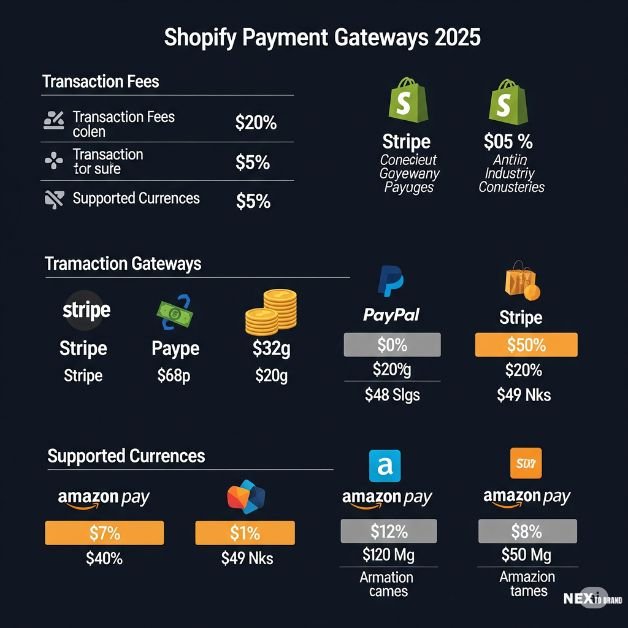
Shopify Payment Gateways Comparison (2025 Update)
Pros and Cons of Major Gateways
Picking a payment gateway for your Shopify store can feel tricky. There are a few good choices, but some work better than others depending on your needs. I’ve tried a few, and here’s what I learned.
- Shopify Payments
- Pros:
- Easy to set up.
- Low fees if you use Shopify Payments.
- Works well with your Shopify store.
- Easy to set up.
- Cons:
- Not available in all countries.
- Doesn’t support some payment methods.
- Not available in all countries.
- Pros:
- Quick answer: Shopify Payments is simple and cheap if you’re in the right country.
- PayPal
- Pros:
- Trusted by customers everywhere.
- Offers buyer protection.
- Works globally.
- Trusted by customers everywhere.
- Cons:
- Higher fees.
- Slow payouts for new accounts.
- Higher fees.
- Pros:
- Quick answer: PayPal is trusted and great for international sales, but it has higher fees.
- Stripe
- Pros:
- Best for subscriptions.
- Flexible and customizable.
- Supports many currencies.
- Best for subscriptions.
- Cons:
- Harder to set up if you’re not tech-savvy.
- Accounts can be frozen for reviews.
- Harder to set up if you’re not tech-savvy.
- Pros:
- Quick answer: Stripe is best for subscription-based stores but may be tricky to set up.
- Authorize.net
- Pros:
- Good fraud protection tools.
- Works well for high-ticket items.
- Handles multiple currencies.
- Good fraud protection tools.
- Cons:
- Higher monthly fees.
- Harder to integrate with Shopify.
- Higher monthly fees.
- Pros:
- Quick answer: Authorize.net is good for large businesses, but it’s more expensive.
Comparison Table: Shopify Payments, PayPal, Stripe, Authorize.net
| Feature | Shopify Payments | PayPal | Stripe | Authorize.net |
| Transaction Fees | Low (2.9% + 30¢) | High (2.9% + 30¢) | 2.9% + 30¢ | 2.9% + 30¢ |
| Global Reach | Limited | Global | Global | Global |
| Setup Ease | Easy | Easy | Hard | Moderate |
| Recurring Payments | No | No | Yes | Yes |
| Support for Multiple Currencies | Limited | Yes | Yes | Yes |
| Fraud Protection | Basic | Basic | Advanced | Advanced |
| Best For | Easy, low-fee stores | Trust & reliability | Subscription-based | High-ticket items |
Quick answer: Shopify Payments is simple and cheap, PayPal is global and trusted, Stripe is perfect for subscriptions, and Authorize.net is best for big orders.
Which Gateway Is Best for Your Business Model?
Choosing the right gateway depends on your store. Here’s who should use which one.
- For Subscription Stores: Stripe is the best. It’s built for recurring payments.
Quick answer: Stripe works well for subscriptions. - For High-Ticket Items: Authorize.net is better for large transactions. It offers solid fraud protection.
Quick answer: Authorize.net is great for high-ticket items. - For International Sales: PayPal is perfect. It works in most countries and is trusted by customers.
Quick answer: PayPal is best for international customers. - For Simplicity and Low Fees: Shopify Payments is the easiest and cheapest if you’re selling locally.
Quick answer: Shopify Payments is the best choice for simplicity and low fees.
Final Thoughts: Choosing the Right Gateway
Picking the right payment gateway isn’t hard once you know what each one does. Shopify Payments is simple and cheap. PayPal works for international sales. Stripe is great for subscriptions. Authorize.net is good for high-ticket items.
Main takeaway: Choose your gateway based on what suits your business. Whether it’s low fees, global reach, or subscription payments, the right gateway can boost your sales and reduce headaches.
By understanding what each gateway offers, you’ll make a smarter decision. It’s all about choosing what works best for you and your customers.
FAQs (Optimized for Featured Snippets & Voice Search)
How do I set up payments on Shopify?
Setting up payments on Shopify is straightforward, and it’s one of the first things you’ll want to tackle once you start your store. To begin, you’ll want to activate Shopify Payments (if you’re eligible) or connect a third-party payment provider like PayPal or Stripe. Shopify walks you through the steps in your admin panel, so you won’t be left wondering what to do next. I found it super helpful when I started, as it saved me a lot of time and headaches. Once you’re set up, you’re ready to accept payments from customers, and the system will automatically take care of everything behind the scenes.
When I first set it up, I made sure to double-check the payment gateways and fees to ensure smooth transactions for my customers. It’s an easy process, but definitely worth paying attention to upfront!
What is the best payment gateway for Shopify?
The best payment gateway really depends on your business and where you’re selling. Shopify Payments is usually the most cost-effective choice for store owners, especially if you’re selling in your local market. It integrates seamlessly with your Shopify store and has low transaction fees. If you’re selling internationally, though, PayPal is a great option because it’s widely recognized and trusted by customers around the world. If you run a subscription-based business, Stripe might be your best bet since it’s designed for recurring payments.
I started with Shopify Payments because it was simple and cost-effective. But as my business grew and I started selling more internationally, I added PayPal to make the checkout experience smoother for my global customers. It’s all about finding the right mix for your business model.
Can I use multiple payment options on Shopify?
Yes, you can! One of the great things about Shopify is that it allows you to offer multiple payment options to your customers. Whether it’s Shopify Payments, PayPal, or Stripe, you can have them all set up at the same time. This flexibility is a game-changer because it lets your customers choose how they want to pay, which can help reduce cart abandonment and increase sales.
I’ve personally had great success with this approach. Offering more payment options made my customers feel more comfortable, especially those who preferred PayPal or needed the flexibility of paying with a credit card through Stripe.
Does Shopify allow Stripe and PayPal together?
Yes, Shopify allows you to use both Stripe and PayPal simultaneously. This gives your customers even more options for checkout. Stripe is fantastic for card payments, especially for subscription-based stores, while PayPal is great for international transactions or customers who prefer its buyer protection.
I started with PayPal because it was familiar to my customers, but adding Stripe later on helped my subscription service grow without any issues. It’s like giving your customers a choice of payment lanes, which can lead to more completed sales.
How do I enable multi-currency on Shopify?
If you plan to sell internationally, enabling multi-currency is essential. Shopify makes this process super easy. You just need to go into your Shopify Payments settings, turn on multi-currency, and it will automatically allow customers to pay in their local currency. This feature is especially helpful if you’re running a global business, as it helps you avoid any confusion about pricing and makes your store feel more local to your customers.
I remember the first time I switched on multi-currency. It was a huge relief to know that customers would see prices in their own currency, and Shopify would handle all the conversions automatically. It made the shopping experience so much smoother for everyone.
How are taxes handled in Shopify Payments?
Shopify takes care of tax calculations automatically, which is a huge time-saver. You can set tax rates based on the region or country where you’re selling, and Shopify will apply them at checkout. For U.S. stores, Shopify also helps you stay compliant with sales tax laws, making sure you’re collecting the right amount based on the state or region. For international sales, Shopify can calculate VAT and other taxes, so you don’t have to worry about manually figuring that out.
When I first set it up, I was relieved to see how simple it was. I didn’t need to calculate taxes for every order—Shopify did it all for me. It gave me peace of mind knowing my store was tax-compliant without extra effort on my part.
Conclusion: My Final Thoughts on Setting Up Shopify Payments
Setting up Shopify Payments was one of the best things I did for my store. When I first started, I didn’t fully realize how much it would improve my sales. But once I got everything right, I noticed a big difference. Payments became smoother, and customers trusted me more.
Key Points to Remember
We’ve covered a lot in this guide. Setting up Shopify Payments, choosing the best payment gateways like PayPal or Stripe, and improving the checkout process all play a big role in your store’s success. Plus, things like fraud protection and handling abandoned carts can make a huge impact.
A Personal Story About Trust and Sales
When I first set up my payment system, I was worried about making mistakes. But once I got Shopify Payments and PayPal running smoothly, everything changed. Sales went up, and so did my customers’ trust in my store. It wasn’t just about tech—it was about giving customers a better experience. The easier you make it for them to pay, the more likely they are to buy.
Take Action: Set Up Your Shopify Payments Today
If you haven’t set up Shopify Payments yet, don’t wait! It’s time to make sure your payment system works well. Whether you sell locally or globally, getting your payment setup right will help your sales and make your customers feel confident. Trust me, once you have it all set up, it’ll feel like your store is running on autopilot.
Learn more about Shopify Marketing Strategies

